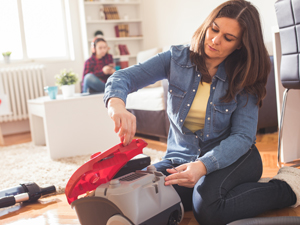What do you do if you’re ready to vacuum your home, but your vacuum won’t turn on? Maybe it was on and working fine, but then it just turned off all by itself and won’t come back on again. Before you bring your vacuum to a repair shop, try troubleshooting. You may be able to resolve the problem yourself.
Check Your Power Supply
Did you plug in the vacuum? Yes, of course you did. Moving right along…
Are you using an extension cord? Perhaps the extension cord you are using is not designed to handle the wattage and amps of your vacuum. Try plugging the vacuum directly into an outlet. If it turns on, then you know the extension cord is the problem and not the vacuum itself.
Are you plugging your vacuum into a power strip? A high current-demand device like a vacuum is best plugged directly into an outlet. If you must use a power strip, first unplug other devices on that strip.
Check Breakers
Check to see if a breaker switch may have tripped. This would explain why your vacuum won’t turn on — because there is no power going to the outlet. Before you reset the breaker switch, consider why the breaker tripped in the first place. Perhaps you have too many heavy power consuming devices plugged in on the same circuit. If you think this may be the case, either redistribute the devices or plug your vacuum into an outlet that is not overtaxed.
If your breaker tripped because of a short circuit or a ground fault, you may smell burning or see black or brown discoloration. You need to call an electrician right away.
Overheated Motor
If your vacuum was working fine and then suddenly shut off, it may have overheated. Most vacuums are equipped with a thermal protector safety switch that won’t allow the motor to run when it becomes overheated. You will need to wait for 30 minutes to 2 hours, depending on your machine, to try again. Meanwhile, you can investigate what may have caused your vacuum to overheat. Unplug your vacuum. Check if there is some sort of blockage that is causing the motor to work harder than normal. Clean the filters and inspect the hoses and passages, especially those leading to the dirt container. Remove any blockages if you find them.
Hopefully you’ve identified and resolved your vacuum problem. If not, you still may not need to buy a new vacuum cleaner. Take it to a professional who may be able to repair it.
This is one of a series of articles written and published on behalf of surpHaces Partners.

